Related Research Articles

The Doge of Venice, sometimes translated as Duke, was the chief magistrate and leader of the Republic of Venice between 726 and 1797.

The Doge's Palace is a palace built in Venetian Gothic style, and one of the main landmarks of the city of Venice in northern Italy. The palace was the residence of the Doge of Venice, the supreme authority of the former Republic of Venice. It was built in 1340 and extended and modified in the following centuries. It became a museum in 1923 and is one of the 11 museums run by the Fondazione Musei Civici di Venezia.
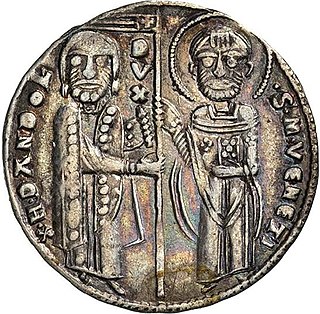
Enrico Dandolo was the Doge of Venice from 1192 until his death. He is remembered for his avowed piety, longevity, and shrewdness, and is known for his role in the Fourth Crusade and the Sack of Constantinople. Dandolo died in 1205 in Constantinople and was buried at the Hagia Sophia.

The Patriarchal Cathedral Basilica of Saint Mark, commonly known as St Mark's Basilica, is the cathedral church of the Catholic Patriarchate of Venice; it became the episcopal seat of the Patriarch of Venice in 1807, replacing the earlier cathedral of San Pietro di Castello. It is dedicated to and holds the relics of Saint Mark the Evangelist, the patron saint of the city.

Marino Faliero was the 55th Doge of Venice, appointed on 11 September 1354.

The bucentaur was the ceremonial barge of the doges of Venice. It was used every year on Ascension Day up to 1798 to take the doge out to the Adriatic Sea to perform the "Marriage of the Sea" – a ceremony that symbolically wedded Venice to the sea.

The House of Contarini is one of the founding families of Venice and one of the oldest families of the Italian Nobility. In total eight Doges to the Republic of Venice emerged from this family, as well as 44 Procurators of San Marco, numerous ambassadors, diplomats and other notables. Among the ruling families of the republic, they held the most seats in the Great Council of Venice from the period before the Serrata del Maggior Consiglio when Councillors were elected annually to the end of the republic in 1797. The Contarini claimed to be of Roman origin through their patrilineal descendance of the Aurelii Cottae, a branch of the Roman family Aurelia, and traditionally trace their lineage back to Gaius Aurelius Cotta, consul of the Roman Republic in 252 BC and 248 BC.
Pietro IV Candiano (925–976) was the twenty-second (traditional) or twentieth (historical) doge of Venice from 959 to his death. He was the eldest son of Pietro III Candiano, with whom he co-reigned and whom he was elected to succeed.
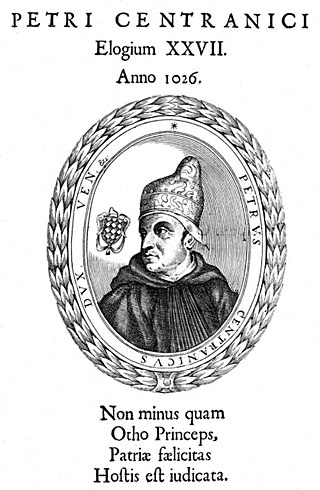
Pietro Barbolano was the 28th Doge of Venice. Reportedly a descendant of the legendary Eraclea, he was elected by the assembly of the nobles after the deposition of his predecessor, Otto Orseolo. The dates of his birth and death are unknown.
The Venetian grosso is a silver coin first introduced in Venice in 1193 under doge Enrico Dandolo. It originally weighed 2.18 grams, was composed of 98.5% pure silver, and was valued at 26 denarii. Its name is from the same root as groschen and the English groat, all deriving ultimately from the denaro grosso.
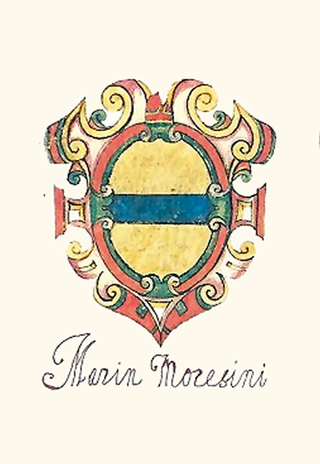
Domenico Morosini was the thirty-seventh doge of the Republic of Venice, reigning from 1148 until his death in 1156.

The Signoria of Venice was the supreme body of government of the Republic of Venice. The older Commune of Venice was replaced by the Signoria from 1423 on, being later officially adopted in the Promissione Ducale by Cristoforo Moro. It constituted a center of power which included the doge's power.
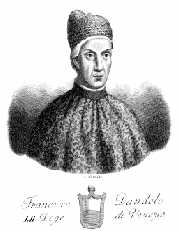
Francesco Dandolo was the 52nd Doge of Venice. He ruled from 1329 to 1339. During his reign Venice began its policy of extending its territory on the Italian mainland.
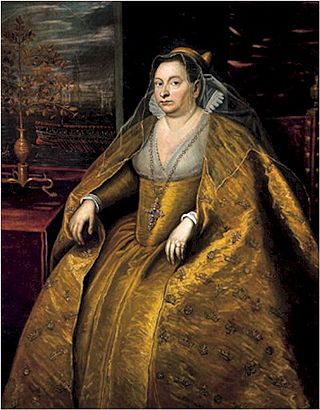
Dogaressa was the official title of the wife of the Doge of Venice. The title was unique for Venice: while the head of the Republic of Genoa were also called Doge, the wives of the Doges of Genoa were not called Dogaressa, nor did they have such a public position.

Silvestro Valier or Valiero was the 109th Doge of Venice, reigning from his election on 25 February 1694 until his death six years later. The Morean War between the Republic of Venice and the Ottoman Empire, which had been ongoing since 1684, came to an end during Valier's reign as Doge, in January 1699.
An electoral capitulation was initially a written agreement in parts of Europe, principally the Holy Roman Empire, whereby from the 13th century onward, a candidate to a prince-bishopric had to agree to a set of preconditions presented by the cathedral chapter prior to electing a bishop to a vacant see.
The Venetian Inquisition, formally the Holy Office, was the tribunal established jointly by the Venetian government and the Roman Catholic Church to repress heresy throughout the Republic of Venice. The inquisition also intervened in cases of sacrilege, apostasy, prohibited books, superstition, and witchcraft. It was established in the 16th-century and was abolished in 1797.
This is an alphabetical index of people, places, things, and concepts related to or originating from the Republic of Venice. Feel free to add more, and create missing pages.

The Tomb of Doge Leonardo Loredan is a monumental 16th-century burial site located in the Basilica of Saints John and Paul in Venice, Italy. Interred in it are Leonardo Loredan, 75th Doge of Venice, and his descendant Francesco Loredan, 116th Doge of Venice, both members of the Santo Stefano branch of the House of Loredan.
